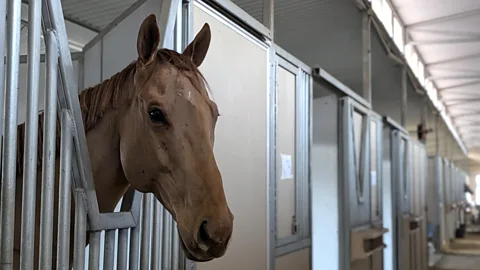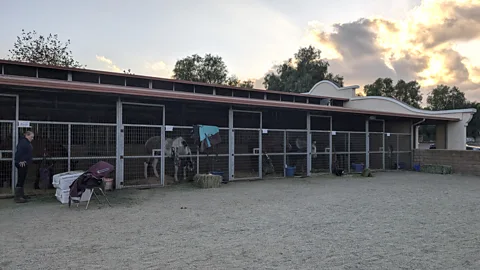'I drove as fast as I could': What happened to Malibu's horses when the fire hit
 Getty Images
Getty ImagesWildfires are becoming more common in Southern California – where horse riding is a popular pastime. So what happens to horses when disaster hits?
The call came in the middle of the night. "There's a fire in Malibu, go check on your horse," Jocelyn Writer, a model living in Los Angeles, was told. "That was it," she says. "I wasn't sure where the fire was, or how big it was. And most of all I wasn't expecting to be driving through it."
But during Southern California's recent Franklin Fire, that's exactly what Writer had to do at 2am to rescue her horse Cashew, a caramel-coloured stallion who was boarding at Zad Ranch stables, a picturesque retreat for equines with ocean views. The blaze, which more than 1,300 firefighters have been battling since it started on 9 December, forced thousands to evacuate from the wealthy enclave. It burned more than 4,000 acres (16.2 sq km), but is now 100% contained as of 18 December. There were dramatic scenes over the mountains which border the Pacific Ocean as helicopters were deployed to drop water on the flames, which damaged 27 structures and destroyed 19 – although there were no human fatalities.
"I was worried Cashew would burn or be stuck in his stall with the fire," Writer continues. "I drove as fast as I could to get to him."
 Lucy Sherriff
Lucy SherriffA video Writer sent to the BBC shows her driving through a blazing inferno either side of the road, smoke billowing, trees on fire and lights flashing from emergency service vehicles.
"It took us hours to evacuate all 30 horses from the ranch. They were pacing back and forth, they just wanted to run away.
"We used some horse trailers that we had on the property and some from friends, but it was hard because we were only able to fit seven horses in the trailers at a time, so we had to do a lot of trips."
The blaze spread quickly due to dry conditions and Santa Ana winds, a natural phenomena in Southern California which occurs when air from the dry desert region of the southwestern US flows towards to California coast, through mountain passages. They're typically warm, and strong, and increase the wildfire risk because of the speed which they can spread flames.
The Red Cross established evacuation centres in nearby Pacific Palisades and Santa Monica, which were open to residents and small pets. But the shelters couldn't take the larger animals from Malibu, of which there were many thanks to the multiple stables, ranches and farms that exist in the area. They went to Pierce College in Woodland Hills, Los Angeles, which works in partnership with the Red Cross and can house around 200 horses, alongside cows, pigs, goats and other farm animals. The college's president said the shelter can be expanded to accommodate more animals as the school staff is trained for a situation like this. "We will stay open as long as we need to until the fire is over, and it's safe for them to return," Aracely Aguilar, the Pierce College President, said in a statement.
"Partners are essential in supporting a community in the aftermath of a disaster," says Stephanie Fox, who works at the American Red Cross National Headquarters. "While the American Red Cross aims to accommodate smaller pets, we rely on the support of groups like Pierce College, who have the facilities and staff, to best care for larger animals.
"Due to the climate crisis, we're seeing more frequent and more impactful disasters that are taking a substantial toll on communities," adds Fox. "As needs grow, these partnerships [with colleges like Pierce] become even more important to ensure comprehensive support anywhere a disaster strikes."
Cashew was one of the animals that found itself at the college – and so was Debra Fine's horse Athena. Fine heard about the fire on Monday night, when the owner of the ranch where she boards her horse called to say he could see smoke billowing from one of the ranch's barns. The next morning, the owner called Fine again to say the fire was getting too close, and she had to come and rescue her horse.
"There were about 15 of us who all went up together. We own about 30 horses between us, so we divided them up and took them to various safe places – we brought about 10 of the horses to Pierce.
 Lucy Sherriff
Lucy Sherriff"I can't believe how easy it's been," Fine adds. "Everybody really came together and everyone at the college absolutely had it down."
Volunteers deliver hay to the horses by 3pm every afternoon, and Fine is free to visit her horse whenever she likes. The college provided shelter to 41 horses, two cows and a pig, and assistance is provided by LA County's volunteer Equine Response Team, which helps care for the animals. The team works year-round to educate horse owners about disaster preparedness due to the unique challenges of owning horses in Southern California. Owners are advised to ensure their horses are trained to be loaded into trailers, to have an evacuation plan – including escape routes and know which vehicles are available, and to evacuate early when there is an evacuation advisory, rather than waiting for the mandatory evacuation order.
Anyone living in a wildfire-prone area like Southern California needs to be prepared – both physically and emotionally, says Bob Roper of the Western Fire Chiefs Association. "They should understand what a wildfire is and is not, so they do not panic. Like a person having a 'go-kit', a person caring for an animal should have extra food, bedding and any medications. Like with people, they should know their escape routes and be ready if directed to evacuate. Likewise, if they cannot evacuate in time, they should know what to do."
 IFAW
IFAWRoper added that although counties have animal control services that can help, there's usually not enough government services to handle the demand in emergency services. "Animal communities usually have volunteer groups that can be mobilised to help, but all this needs advance preparation and disaster training," he says.
Malibu's equestrian community is becoming all too familiar with the drill as wildfires grow increasingly more frequent and severe in Southern California. Malibu is particularly impacted by fire, with 99% of properties being at risk of wildfire damage. In 2018, the Woolsey Fire burned more than 85,000 acres (344 sq km) of land and impacted almost 16,000 buildings.
In the past, the International Fund for Animal Welfare (IFAW) has provided emergency help to animals in California during wildfires. Kelly Johnston, a senior programme officer with the non-profit, says that large animal owners need to be more prepared living in wildfire prone areas. "Large animals are more difficult to evacuate," she says. "Those who own large animals or other animals unable or unaccustomed to being contained and being driven elsewhere need to do more planning for their family."
CARBON COUNT
The emissions from travel it took to report this story were 20kg CO2. The digital emissions from this story are an estimated 1.2g to 3.6g CO2 per page view. Find out more about how we calculated this figure here.
Fires can be so fast moving, she adds, so owners are given little time to get to safety – and if the animal's owner lives somewhere else, planning and preparation becomes even more vital. "Evacuation of all large animals is not always possible or required, so plans to ensure the best possible outcomes for your larger animals in a variety of situations is also needed."
Johnston suggests a number of steps that large animal owners can take to prepare for wildfires. Working with neighbours and friends with trailers to come up with disaster plans – and practising them in advance is "critical", she says. "Getting animals accustomed to being loaded and doing it with positive reinforcement regularly, increases your odds of a faster and smoother loading and evacuation."
More like this:
• How restoring rivers' curves prevents flooding
Having a week's worth of medication and food somewhere that's easy to find is also helpful, as is planning where you would take your animals during a disaster.
"Disasters are becoming more frequent and more ferocious," Johnston adds. "It is important that communities plan and prepare for all types of disasters with their residents, including plans for animals."
Writer says she is taking precautionary steps for when the next fire happens. "I'm getting a trailer of my own, so when this happens again I can get my horses out faster."
--
For essential climate news and hopeful developments to your inbox, sign up to the Future Earth newsletter, while The Essential List delivers a handpicked selection of features and insights twice a week.
